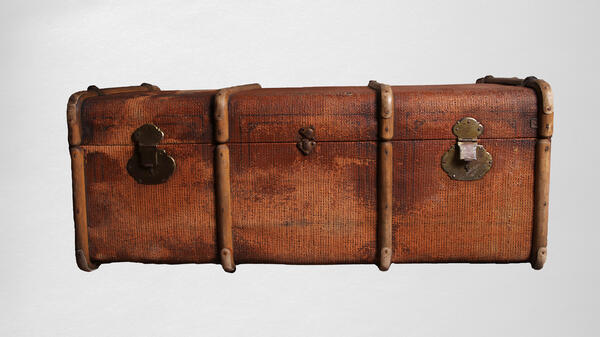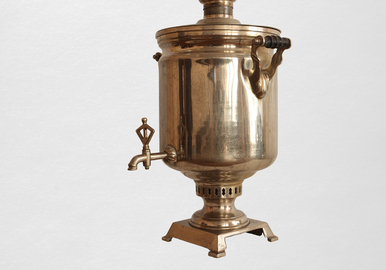The Siberian Route was an important trade route from the European part of Russia to the Chinese borders. It influenced the development of many Siberian settlements, including the village of Kiiskoye (the former name of Mariinsk). Voluntary settlers, mainly peasants, artisans, and travelers were the first to use the route.
Though the way to Siberia was hard, people went there to look at this poorly explored region. Only wealthy people could usually afford this journey.
The museum houses a travel chest. This is the chest the travelers usually took in Siberia. They were comfortable for carrying everything needed on the road: dishes and utensils for cooking, coffee or tea sets, candlesticks and lamps, watches, toiletries, and cases for small items. During the trip, the chests were attached to a carriage roof or a back of a tarantass.
The chest from the museum collection is covered with fabric and painted brown. Leather handles are attached to its sides with metal plates. There are three decorative metal plates on the front of the chest. The outer plates have locks, and the central ones have a small latch to keep the lid closed. The flap lid is attached to the chest with three black metal hinges.
Riveted metal strips on the sides protect the chest from damage. They are decorated with wooden bars. The lid, front, and sides of the chest are embellished with a geometric pattern of rectangles. The inner walls, bottom, and lid are overlaid with light brown paper.
At the end of the 19th century, travel chests were used to store and transport things. One can find the description of these accessories in many works of Russian writers: for example, in ‘The Captain’s Daughter’ by Alexander Pushkin, or in “Dead Souls” by Nikolay Gogol. Leo Tolstoy also mentioned them in his novel “Boyhood”:
Though the way to Siberia was hard, people went there to look at this poorly explored region. Only wealthy people could usually afford this journey.
The museum houses a travel chest. This is the chest the travelers usually took in Siberia. They were comfortable for carrying everything needed on the road: dishes and utensils for cooking, coffee or tea sets, candlesticks and lamps, watches, toiletries, and cases for small items. During the trip, the chests were attached to a carriage roof or a back of a tarantass.
The chest from the museum collection is covered with fabric and painted brown. Leather handles are attached to its sides with metal plates. There are three decorative metal plates on the front of the chest. The outer plates have locks, and the central ones have a small latch to keep the lid closed. The flap lid is attached to the chest with three black metal hinges.
Riveted metal strips on the sides protect the chest from damage. They are decorated with wooden bars. The lid, front, and sides of the chest are embellished with a geometric pattern of rectangles. The inner walls, bottom, and lid are overlaid with light brown paper.
At the end of the 19th century, travel chests were used to store and transport things. One can find the description of these accessories in many works of Russian writers: for example, in ‘The Captain’s Daughter’ by Alexander Pushkin, or in “Dead Souls” by Nikolay Gogol. Leo Tolstoy also mentioned them in his novel “Boyhood”:



